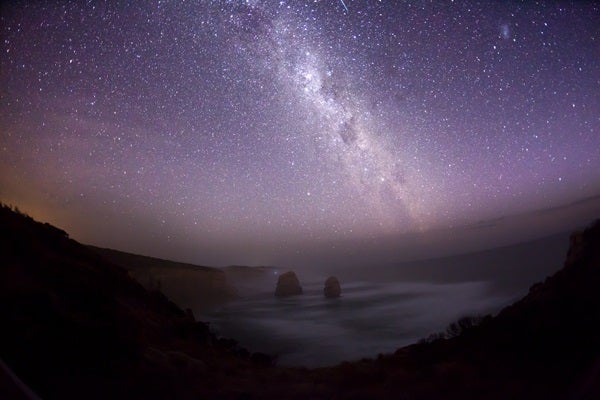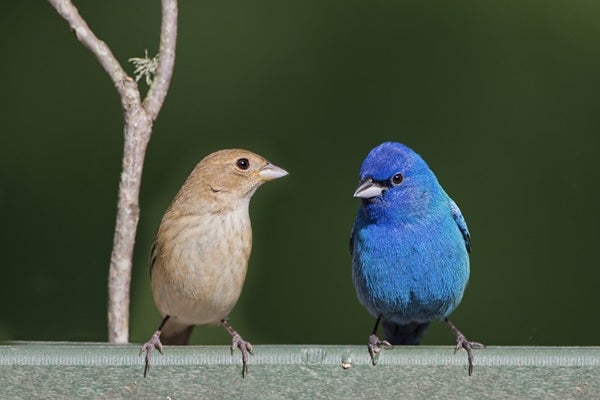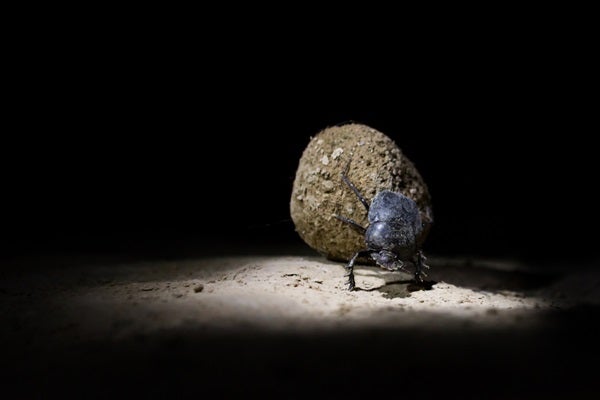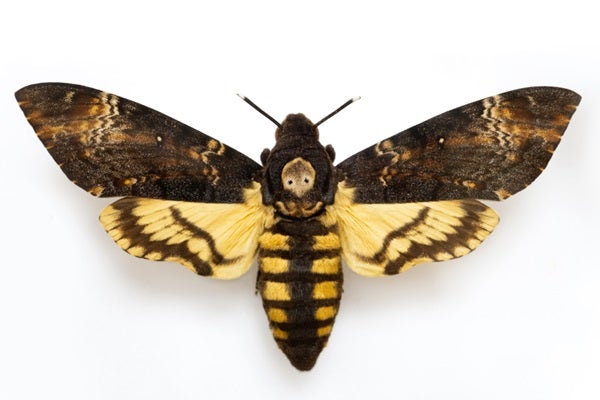Humans have a complicated relationship with the night. We schedule most of our important tasks in the daylight hours, reserving the darkness for rest, relaxation, and, on clear nights, wonder. For many animals, however, the night is anything but restful.
Nocturnal foragers begin their days at sunset. Some marine species reproduce exclusively in the privacy of the night. Caged migratory birds jump and flap repeatedly after sunset, entering a state German ornithologists named Zugunruhe, meaning migratory restlessness. Indeed, the night is an excellent time for many animals to be active.
Some are evolutionary refugees, using night to elude daytime competitors, predators, or parasites. Others avoid the heat of the day by restricting their activity to cooler nighttime hours. Itinerant animals, departing on long and treacherous journeys, may also use the setting Sun to make last minute adjustments to their internal compasses.
Those restless migratory birds are one such group, invoking a range of navigational systems during their travels. In the day they use a ‘Sun compass,’ adjusting their headings relative to the Sun’s current position, and accounting for its daily movement. And after sunset, they rely on patterns of stars to guide them.
In the case of the indigo bunting, a songbird that migrates between North and Central America, these patterns lie within 35° of the star Polaris. Birds kept in a planetarium overnight, restlessly hopping in their desired travel direction, lose their bearings only when this region is completely blocked from view.
Later experiments, in which young birds viewed a planetarium sky rotating around the star Betelgeuse, found that the birds learned this star, and not Polaris, as their true North. These birds, and likely many others, are able to learn the pattern of stars surrounding the center of celestial rotation, allowing them to pinpoint the poleward region of the sky.
Learning to find the center of rotation is a convenient but robust strategy, that, unlike the Sun compass, does not rely on their internal clock. Jetlagged birds viewing the evening Sun are fooled into flying in the wrong direction, choosing their bearing as if the Sun were at its noontime azimuth (apparently ignoring its lower elevation). But those kept overnight in a planetarium projecting an earlier or later sky — a virtual ‘displacement’ East or West of thousands of kilometers — appear unphased by this longitudinal detour.
To adjust for movements of both the Sun and stars with any accuracy, migratory birds would require two internal clocks synchronized to solar time and sidereal time, respectively. But by learning to identify the center of rotation, they avoid this complication. It seems birds forgo sidereal time in favor of their more straightforward strategy.
A starry night in broad brushstrokes
While birds sometimes favor simplicity over sophistication, insects are true masters of minimalism. Their bodies are too small for brains or eyes as large as those carried by birds, so they make do with what they have. What’s more, when it comes to detecting patterns of stars, insects appear to have taken a wrong turn along their evolutionary path.
Unlike the eyes of humans and birds, in which a single lens focusses the light field onto the retina, insects evolved ‘compound eyes’ consisting of multiple facets. Each facet includes a single lens projecting onto a distinct group of light-sensors. This modular design is a good first step from a single light-sensing organ to an eye that detects spatial detail — instead of modifying the organ, just duplicate it to add more image ‘pixels.’
But compound eyes reach an awkward trade-off in dim light. Larger lenses collect more light, and good resolution requires many lenses, enlarging eyes to the limits of what an insect cannot afford. To compensate, most nocturnal insects have removed the tissue between facets, allowing multiple facets to project onto a single set of light-sensors: a ‘superposition’ compound eye. The broader beam reaching each sensor boosts sensitivity, but the optics still rarely bestow enough resolving power to distinguish individual stars. Instead, insects likely see a van Gogh-style starry night: smooth patches of light and dark across the sky. But that does not stop them from following the stars.
As the Sun sets over the South African savannah, nocturnal dung beetles emerge. Dung is an excellent source of water and nutrients in a harsh environment, so they compete with a myriad of dung-eating insects converging on each dung heap. To save themselves a portion of the feast, some beetles sculp themselves a ball and roll it away, escaping their competitors. To achieve this, they must roll their ball in a straight line. While their day-active counterparts use the Sun as their reference point, like the birds’ Sun compass, nocturnal dung beetles instead rely on the Milky Way.
Through their superposition compound eyes, a beetle’s view of the night sky is certainly no detailed star chart. But the pattern they do see contains all the information they need. The streak of the Milky Way forms a dominant feature across skies in the Southern Hemisphere, with the higher relative density of stars closer to the galactic center producing a brightness gradient across the sky.
This difference helps the beetles to hold a straight course long enough to escape their competitors. In fact, dung beetles placed in a planetarium can roll straight when all stars are switched off but the faint streak of the MIlky Way remains. No surprise perhaps that a dung beetle favors the quick-and-dirty solution.
Over our heads
The story of the dung beetle is likely just a microcosm of grander journeys taking place unseen above our heads each night. When ecologists first pointed their radar systems upwards to detect high-flying insects, they discovered nighttime migrations ranging into millions of individuals drifting quietly overhead.
These are harder to monitor than migrating birds, since their small bodies and wings cannot support the radio transmitters used to trace the paths of larger migrants. But recently developed very-high frequency radio transmitters, weighing just 240 milligrams, are light enough to be carried by a death’s-head hawkmoth. Transmitted data showed that far from simply drifting with the wind, these moths hold their migratory course by steering actively under their own wing power, covering more than 37 miles (60 kilometers) in a single night.
Many moth species undertake large seasonal migrations. In each dry season, Australian Bogong moths journey from their breeding grounds to cool caves in the snowy mountains — a journey that can exceed 620 miles (1,000 km). To hold their courses over such long distances, they use an internal magnetic compass combined with visual cues. Recent evidence suggests that these moths, and likely many others, use the pattern of stars across the sky to set their heading. If they were to use the dung beetle’s strategy of holding bright and dark patches stable, celestial rotation would cause them to veer off course by the end of the night.
Remarkably, some recent experiments in a miniature field ‘planetarium’ found that moths, in a vertical magnetic field (in which a magnetic compass fails), could pick the correct direction across different times of night and season. Endowed with superposition compound eyes, these moths are unlikely to detect the fine star patterns used by migratory birds. But perhaps they have taken the dung beetle’s compass one step further, using their smudgy view of Milky Way to identify the center of celestial rotation.
End of the journey
Nocturnal insects may not always be able to use the Milky Way as their compass, however. Skyglow is increasing annually, and now outshines the Milky Way by an order of magnitude across much of the inhabited world.
Dung beetles viewing only these polluted starlit skies become lost, rolling around in circles. And those exposed to bright city lights move straight towards the lights, a behavior also observed when even a single lamp is switched on in an area without light-polluted skies. Such lights attract other nocturnal insects as well as migratory birds, which often collide or become trapped. and bogong moths are famous in their homeland for aggregating around the lights of the Australian Parliament House.
It remains unclear what triggers this ‘flight to light’ behavior. A study described in a recent preprint used harmonic radar to track large moths fitted with lightweight transponders. To the researchers’ surprise, only 4 percent of moths released within a ring of streetlights flew towards them. This suggests that, far from doomed to irresistible attraction, moths can navigate between streetlights under the right conditions.
As artificial light spreads, we will need to redesign night-time lighting to offer the conditions demanded by animal astronomers. If not, we risk cancelling these remarkable journeys just as we are beginning to understand them.













